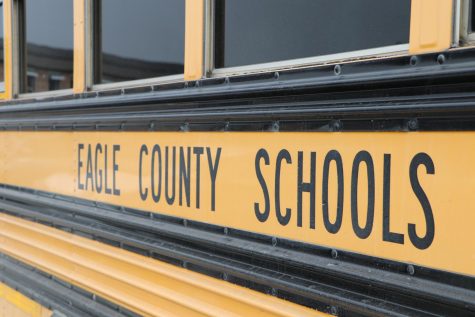Logistical implications limit the feasibility of transitioning to full time in-person learning for the rest of spring semester
The carefully organized hybrid flex mod schedule was created to address the health, safety, and logistical needs of Eagle Valley High School for the 2020-21 school year.
April 28, 2021
As the district considers returning to full time in-person learning, there are several logistics that need to be considered in order to ensure the safety of everyone in the building and to be in compliance with Centers for Disease Control recommendations.
Physical distancing is one of the CDC’s five prevention strategies recommended for safe in-person instruction. It is a necessary measure used to mitigate the spread of COVID- 19 and important in the classrooms, halls, cafeteria, and on the school bus. The amount of physical distance currently required is six feet.
The buses struggle with physical distancing. Students are not able to social distance in the current model, and it will be harder to maintain with more students.

“We could not run transportation if we had to social distance while on the buses, as our resources are limited, and our rider numbers are fairly high here at ECSD,” Timothy Owsley, the Director of Transportation of the Eagle County School District, explains.
The buses have lots of mitigation strategies put in place to keep the students safe, one of which is lowering the capacity of each bus.
“This has limited us to only being able to carry about 1300 students per day total, and we have been averaging 1200 students being transported every day,” Owsley states. “In previous years we would load buses to their capacity and normally transported 1800 students per day or more here in ECSD.”
A return to four days of in-person learning would double the amount of people in the school.
“So a trade-off is the hallways would be much more crowded because we would have less passing time,” Principal Mr. Greg Doan says.
Passing periods would become five minute in order to allow for a seventh hour to be added to the end of the day. The transition to four days a week of in-person learning would cause there to be a change in the schedule as well. In many cases, combining the A day and B day sections of a class results in too large of a class to physically distance. In order to solve this problem, a seventh period would be added.
“We could move kids into the seventh period to keep class sizes below 30,” Mr. Doan explains, “otherwise we would have 30-40 kids in a class.”
Many students have classes that occur at the same time on both A and B days, which would pose a new challenge in an in-person schedule.
“Our messaging to teachers would be being here four days a week doesn’t mean we double up the work,” Mr. Doan emphasizes. “It would mean that if you have kids on an A day you get them again on a B day now, and you just get to work with them longer because some of your kids can’t be there both days.”
This means that students with simultaneous classes still only go to those classes twice a week, and all other students technically only have two days of synchronous work even though they will be in the building for four days.
Powerschool and Schoology would not be altered for students whose schedules are switched to accomodate a seventh period or simultaneous classes.
“So what would happen is your teacher would have known that normally you were in second hour but now we’ve moved you to seventh,” Mr. Doan explains. “So your attendance and your Schoology connection would still be in that previous hour.”
Contact tracing is another mitigation strategy recommended by the CDC that prevents the spread of COVID- 19, especially the spread of asymptomatic cases.
“The new guidance we just got Tuesday [March 18, 2021] was we are no longer doing classroom contact tracing,” Mr. Doan explains. “So if you have any student in any of your classes that comes back positive, we will send out what’s called a low risk warning letter, and this is true whether we change the schedule or not.”
Without contact tracing in place at the schools, quarantines will now only take place when symptoms are being exhibited.
The logistics need to be considered when considering shifting to four days of in-person learning. Physical distancing and schedule both cause a logistical problem in the application of full time in person learning. Along with the removal of another one of the CDC recommended mitigation strategies, contact tracing.






